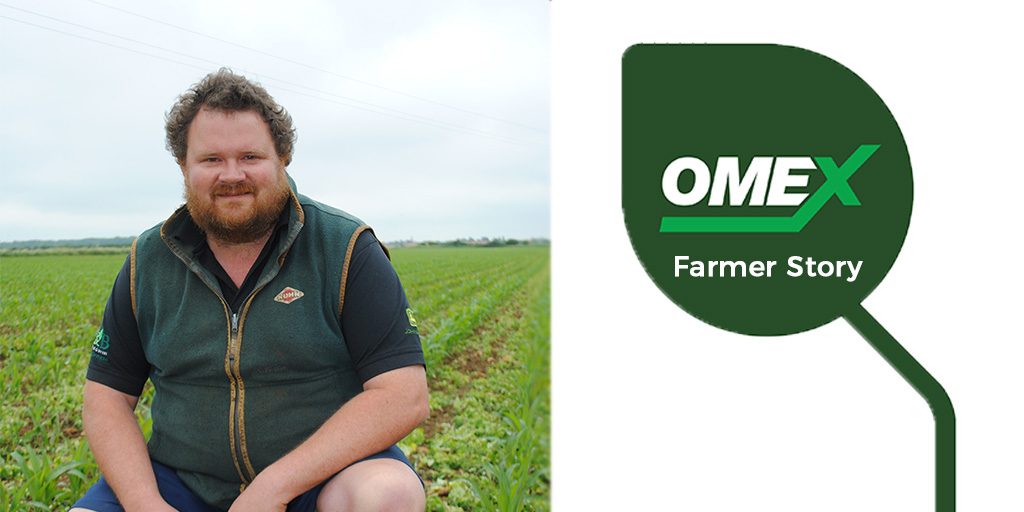OMEX caught up with D and B farming, on how switching to Liquid Fertiliser has helped utilise sprayer machinery.
Switching to a
liquid fertiliser application system from a twin-disc granular spreader is paying dividends for a Lincolnshire farmer, whose company is now more efficient, cost effective, time flexible and has an improved environmental profile.
James Burton of D and B Farming Co Ltd, Leasingham near Sleaford, farms a 162ha arable enterprise that follows a winter wheat and barley rotation. Wheat yields on the mixed clay to sand soils average 9.8t/ha. Land is rented out for maize, which is grown for the local Holdingham
Biogas digester, as well as spinach and
potatoes. The business also operates a 5000ac contract farming business and includes a number of small and large farming operations in the area.
A key focus for James and his brother Simon is to provide a professional and cost effective nutrition and pesticide application service to new and existing customers.
Five years ago the farm made a conscious decision to switch to
OMEX liquid fertiliser because it wanted to better utilise an existing sprayer, improve efficiencies and to remove the problem of fertiliser bag disposal and fertiliser storage.
The business is now totally liquid so the sprayer is applying fertiliser and pesticides to more than 19021 ha/annum.
“The biggest benefit of switching to liquid fertiliser is the extra daily output and a reduction in labour and machinery,” says James. “Fertiliser application is now only a two man operation with me on the sprayer plus the bowser operator.”
The addition of the 1800L bowser has seen output increase to 200ha/day comfortably.
“Maximum daily output achieved on granular was only 150ha,” he says. “The bowser has a 1200l/min pump on it, which takes 15 minutes to fill, so turnaround is significantly quicker than having to empty heavy bags individually into the spreader.”
James says that visually his crops have changed dramatically since switching fertiliser system. He does not need to worry about the moisture levels anymore either. In the past, spreading granular fertiliser in dry conditions could seriously delay the uptake of essential nutrients.
“I’m not sure why we didn’t change earlier,” he says.
OMEX
liquid fertiliser is delivered into tanks strategically positioned on the farm. There are four 50m
3 tanks filled with 24N:7.5S; two are in the yard and two are positioned at the other end of the farm. The season starts with the tanks full and OMEX regularly refills them during the season.
“We get a very good service from OMEX, which is really important to us because we can easily empty two nitrogen storage tanks per day,” explains James. “Every pass includes sulphur and we aim to start applying liquids early in the morning to avoid scorch risk.”
The fertiliser application season starts early too, ideally the third week of February. This gives James greater flexibility and to be more selective on spray days.
“The first and second applications are relatively easy in terms of avoiding scorch, but the third application needs to be done on the best spray day available – ideally dry and still – or when it’s raining,” he says. “We haven’t experienced any scorch with liquids to date.”
He adds that the beauty of a liquid fertiliser system is that the sprayer is virtually always being used to either apply pesticides or nutrition. Increasing the use of the sprayer means that the farm will look to replace it after five years.
“I like to do all the spraying because it means I get the chance to look at the fields more often,” says James. “You can walk fields as much as you like but you can’t see as much as you can from the cab, where you can look down from above the crop.”
He adds that the business is much more efficient now and saves so much time with one sprayer applying liquid fertiliser and pesticides, often in the same tank mix. He can also pass on any bulk purchasing price savings onto his customers.
“With liquids, the customer only pays for what is applied. There is no waste and no bags or large storage buildings needed, so our environmental profile is much better.”
Thinking about how you can utilise sprayer machinery? Find our more about Liquid Fertilisers, by talking to your
local FACTs qualified expert.
